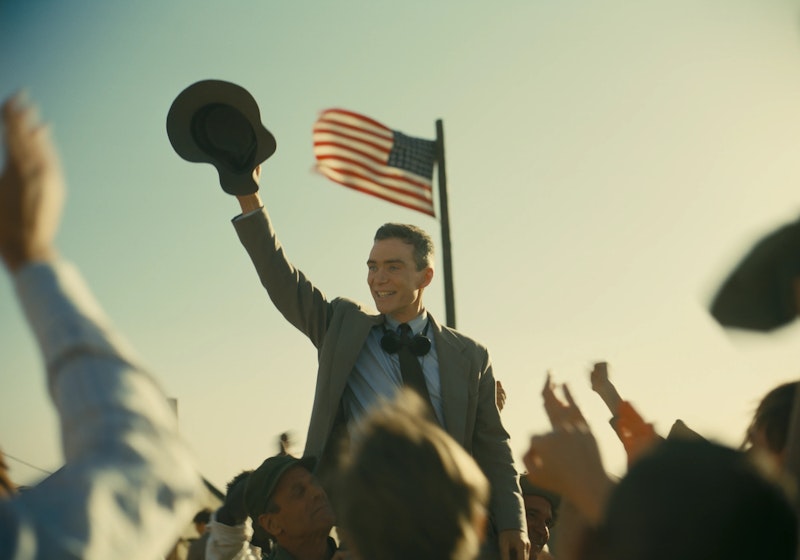At 12:15 on a Saturday afternoon in July, hundreds of people filled The Senator Theatre in Baltimore to see a three-hour biopic about the man who built the atomic bomb. One theater over, a new fantasy comedy subverting a pop culture icon opened to even bigger business, with sold-out shows all day. One was projected on 35mm film; the other, projected digitally.
None of this would’ve been unusual in 2007, or 2013, but the release of Barbie and Oppenheimer isn’t unprecedented, it’s a resuscitation of what going to the movies felt like every weekend just 10 years ago. Box office records may have been set, but my experience at the movies the past three days felt like going back in time, in the best way—unlike Barbie itself, which is regressive, smug, inarticulate, and painfully unfunny.
But important. Millions of people will remember this weekend for the rest of their lives. Putting aside the cynical and sexist as the “BOY/GIRL” marketing of Oppenheimer and Barbie, it’s brilliant that so many people are doing double features in the same day on such an intense cinematic speedball as this. Oppenheimer is the best American film since Once Upon a Time in Hollywood, and the pinnacle of Christopher Nolan’s career thus far. I’ve liked many of his films, especially Interstellar, but none of them come close to his grand masterpiece about J. Robert Oppenheimer, played with precision by Cillian Murphy.
Oppenheimer proves that Nolan is a sentimentalist and a warm, loving filmmaker; its closest analogues are Oliver Stone’s JFK and Nixon, which may be personal to Stone but feel so much more didactic and outside than Nolan’s latest. Oppenheimer begins with raindrops and a slow dolly-in on Murphy, and then it begins: three hours of relentless questioning, score and sound design constantly in the foreground, the camera always slowly, slowly dollying in. Stone’s early-1990s President pics were much flashier and expansive; what makes Oppenheimer so powerful is its control, its steady tightening of its grip, one which never relaxes or resolves, because the question posed by the film and the answers we have are impossible to reconcile. Nuclear war inhibits human beings and human potential, and the world could be obliterated at any moment.
And in all this buildup, all this time—from last Saturday back to July 2022, when the first trailer played before Nope—everyone assumed the showstopper scene in Nolan’s latest would be the Trinity test, or even the bombings of Hiroshima and Nagasaki. The latter two attacks are never directly depicted, but the Trinity test is at the center of the film, and ironically the one sequence I found underwhelming. Nolan cuts the sound out as soon as the bomb goes off, not a problem, but his editing and frame of the blast make it look smaller than it already is; remember, this was a real explosion the filmmakers pulled off practically without special effects.
But to complain that a movie about the black tar heart at the center of mid-century America doesn’t show enough atom bombs going off would be petty. This isn’t Black Sunday, a glitzier disaster movie by John Frankenheimer in an era full of them, a movie that unintentionally hypes the audience up for a blimp to crash into the Super Bowl and explode. Of course it doesn’t happen—but the main complaint on test cards in 1977 was that the Super Bowl wasn’t bombed. It still feels like that today. You want the blimp to crash.
Oppenheimer has none of these issues, and its rigor is astounding. After decades making super hero movies, thrillers, and action epics, Nolan has made his second-first movie. It’s hard to reconcile the fact that this is the same filmmaker who drove a 747 into a warehouse full of priceless fine art in his last film, Tenet. That movie was as absurd and tone-deaf as Oppenheimer is astonishing, the work of a master.
At the end of this praise, it’s important to emphasize that the real showstopper scene isn’t the Trinity test, but the gymnasium pep rally scene shortly after, when the war’s won and Hiroshima and Nagasaki have been bombed. Oppenheimer is speaking to a large group of Americans, and as they cheer him on, the background begins to shake, and all of a sudden the sound cuts out—that incredible smash cut from a woman cheering to a blood curdling shriek—and people crying and dying in the aisles. On his way out, Oppenheimer steps over a charred corpse, barely recognizable as once human. The power of this scene can’t be overstated, the physical effect it had on me in the theater and as I’m writing this is undeniable. It’s simply one of the most powerful and important scenes in the history of American cinema.
—Follow Nicky Smith on Twitter: @nickyotissmith

